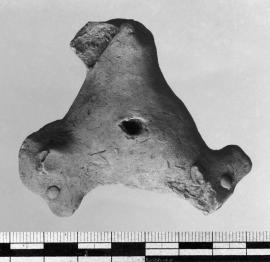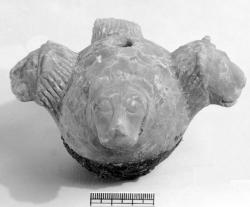A photo of this object, currently on display in our Mesopotamian Gallery, was included in a tweet that recently went viral on the internet with nearly 100,000 likes – and counting. The tweet mistakenly identified the artifact as an early version of the modern-day fidget spinner. It is actually a mace head from ancient Mesopotamia, similar to the example shown in the photograph below from Tell Agrab. The object on display was found in the vicinity of a temple at Tell Asmar, which would support the interpretation, since maces were weapons of the gods. Mace heads were usually made of stone so it is interesting that our example is of baked clay. However, it was often the case, particularly in the early second millennium BC, that objects we might expect to be made in stone were also being made in clay.
So why, then, is this mace head misidentified in our gallery? Our interpretation of the past changes over time. When the object was first published in 1932, the excavators speculated that it might be rotated and used in astrological divination. The Museum is currently updating its displays for the 2019 centennial of the Oriental Institute. In addition to revising the label with its new interpretation, we plan to exhibit the Tell Asmar object alongside other mace heads, as well as votive statues, plaques, and vessels, in a section devoted to objects excavated from temples. In the meantime, we have added a temporary label alongside the object in the current display in response to this recent interest in the artifact. Also on display in this area are toys that survive from ancient Mesopotamia, including baked clay rattles, whistles, animal figurines, and wheeled carts.
View additional objects on display in the Mesopotamian Gallery using our Online Collections Search.
For more news coverage, see:
Becky Little. "Ancient ‘Fidget Spinner’ Is Actually a Weapon." A+E Networks, History.com



